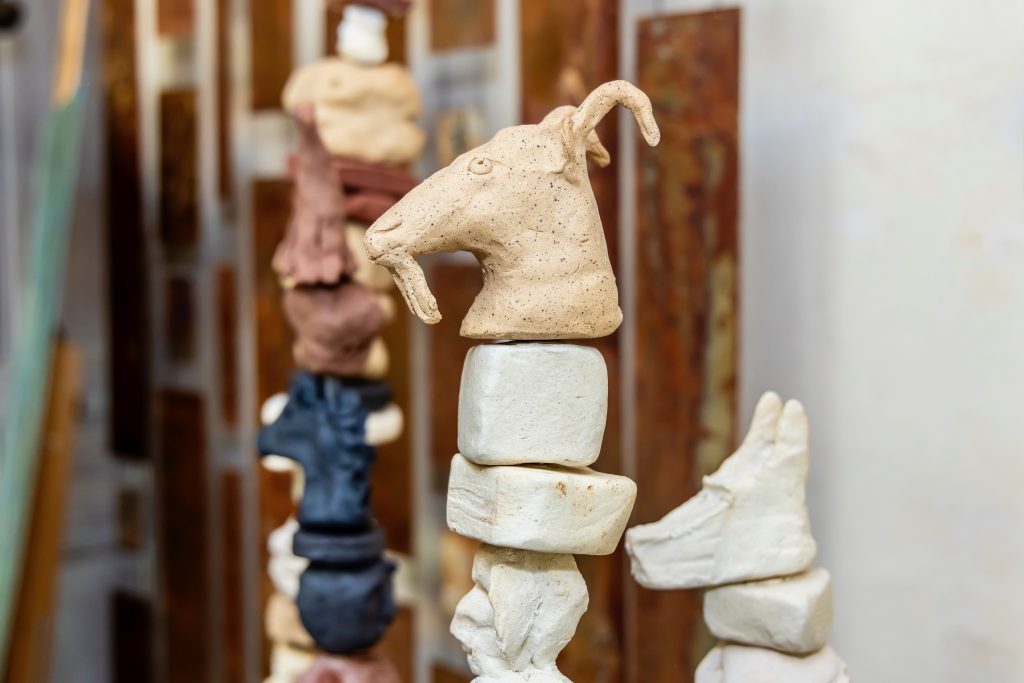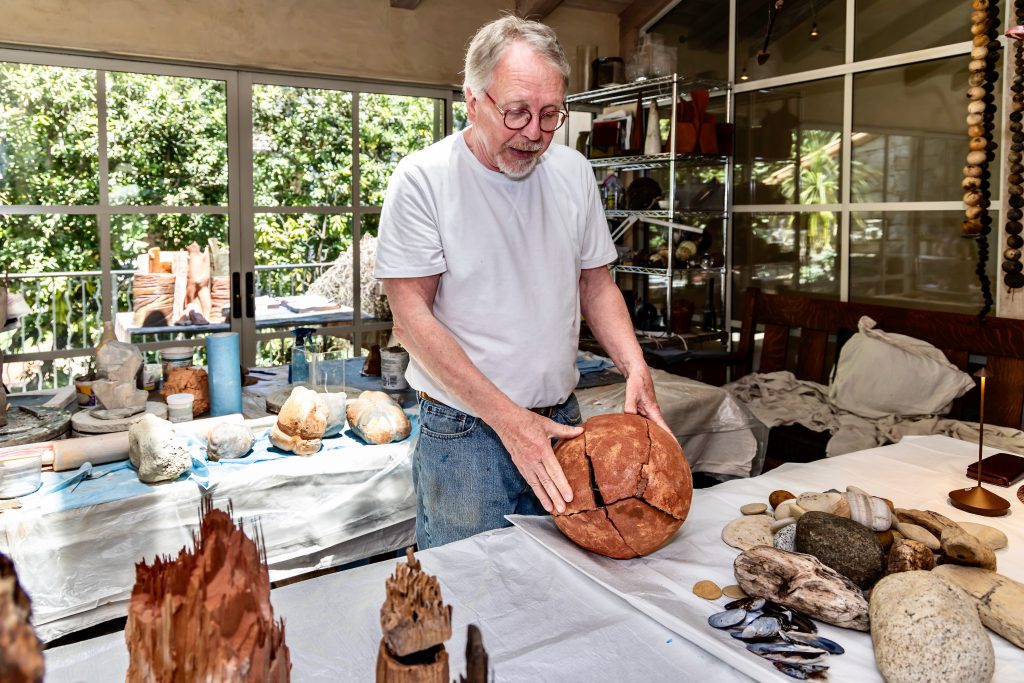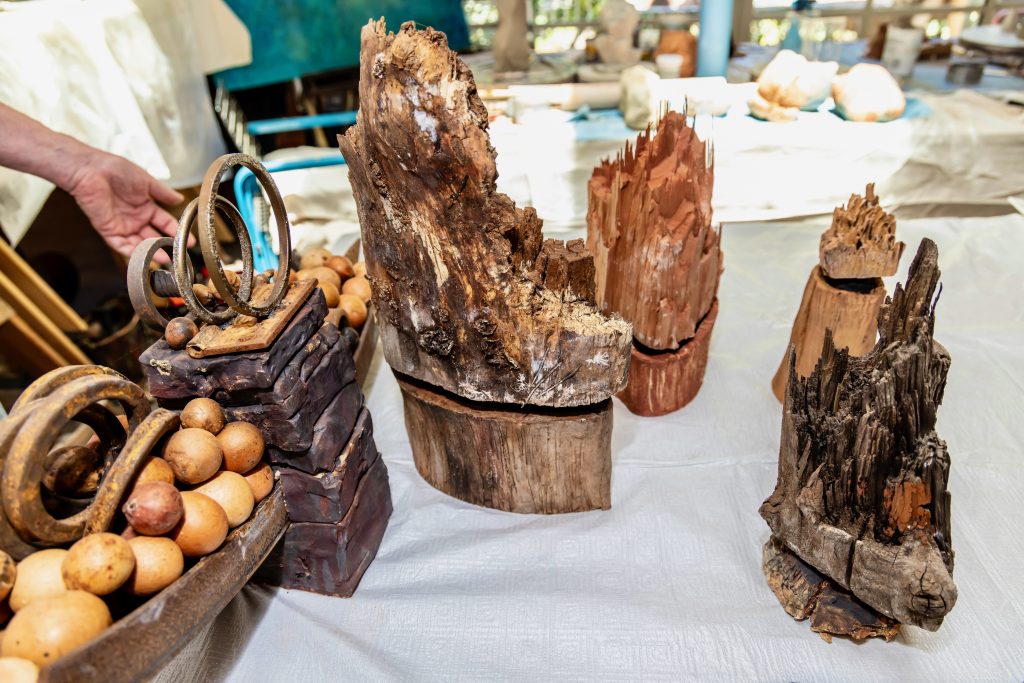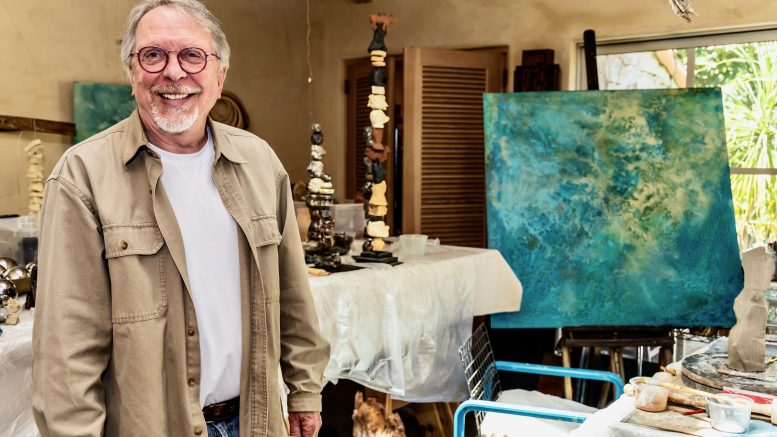By Joan Cusick
Change is a constant for artist William Ishmael.
Twenty years ago, he made the leap to full-time artist after a long and successful career as a civil engineer.
“The similarity between being an engineer and an artist is that as a civil engineer, I had to think in three dimensions — topography, hillsides, cuts and grades, and slopes,” Ishmael said during a recent interview at his art studio. “That’s what you do with art too. You’re thinking it through.”
On any given day in Ishmael’s art studio, you’ll find about a dozen projects in various stages of development — many exploring new media or new techniques. He paints on canvas and on metal. He works in ceramics. He creates art with found objects, both natural and manmade.
“I always have something in mind when I set out,” he said. “But I also let the materials suggest what it should be. It doesn’t end up exactly as I set out because the paint didn’t behave that way, and the metal didn’t behave, or the ceramics didn’t behave that way. It’s just fun to pursue spontaneously — as opposed to an engineer where you’ve got a goal, and you need to design very precisely toward that goal. This is a much more spontaneous endeavor, and I love that.”
Ishmael and his husband, David Gibson, often hike to find natural materials like rocks, driftwood, oak galls that can be elevated through art. But at age 78, Ishmael has decided to do only what he loves.
“Today could be the last day, so I don’t want to spend the last day of my life doing something I don’t want to do,” he explains. “I want to make every day count. Get up, make it count. Have a cup of coffee, walk the dogs. And make it count.”

How did you get into art in the very beginning? Because that’s a pretty big leap from engineering to art.
Well, yes and no. It’s a big leap in terms of how much you earn and how much you get paid. But I’ve always been an artist. I’ve always drawn — I loved to draw.
When I was working full time, I would take water colors in a little day pack on hikes on the weekend, and I’d do watercolor landscapes. Finally it came time, and I was like, “Well, this is becoming more and more interesting to me.” So I took a class with a guy named Jim Estey, who’s passed away, but I took my best watercolors in to him. And they had foreground and middle ground and background, and they had vanishing points. Jim Estey looked at me and he said, “Are you an engineer or something? You need to loosen up.”
Once I loosened up, there’s no going back — letting things happen, putting paint on sheets of metal and tilting the metal so it runs that way, and then so far, let it run this way. I’m really very, very open to chance and accidents. …
If anybody were to ever curate my stuff 100 years from now, they would find layers and layers, because if it doesn’t please me — because of the randomness, it doesn’t always turn out — you can just paint over it. That’s another great thing about paint, where [with] engineers you can’t exactly say, “Let’s redo the bridge, it fell down.”
How long have you been a full-time artist?
I had my first gallery show in 2004, with Pam Skinner. She’s still around, but she doesn’t have a gallery anymore. I had the first gallery show, and I sold a lot. Galleries like artists who sell a lot because they’ve got to keep their doors open.
Every gallerist I’ve ever known — they love art, they love artists, they love the business, but they have expenses. Galleries take 50%. People don’t always realize that, but they earn [that] 50%, is my attitude. They have the space, they have the lighting.
b. sakata garo is where I show now. He’s got beautiful walls that are exposed brick, and then he’s got other walls that are drywall. So when you curate your show, you can choose which wall. He has a beautiful lighting system, plus he’s a pleasure to work with.

You have a lot of irons in the fire, so to speak. What’s next?
I’m painting on canvas and I’m painting on metal. When I scrape to bare metal and add vinegar, it rusts. And so rust is part of the process. That’s transformation of materials.
Ceramics has become much more important. I’m not particularly into utilitarian ceramics. I’m looking at ceramics as sculptural pieces. I’ll do a tall sculptural piece — not a vase. So, if somebody wants a vase, they can stick a bottle in it. But I’m doing it as a sculptural piece.
Then I’m honoring natural materials as they’re found — not manipulating them so much as displaying them and bringing them into prominence. I always love to hike and go out in the woods. We were in Carmel and I collected these rocks from the beach. Those wooden fragments are from a trip to the forest. What I’m doing is honoring objects from nature.
There’s a Japanese art form called Suiseki. They find a precious rock and they just elevate it. So I did the same with the wood. I created ceramic bases to lift up the wood and say, “Look, there, this piece of wood is beautiful.” I’m really enjoying doing that.
One of the other concepts that I’m always playing with is, the whole is greater than the sum of the parts. So, you can take parts and put them together, and the new piece is just a different and a more important piece than it started out with.
For example, I’ve gotten over ceramics breaking, and I’m OK with that. This ball fell off the table. Oh, sorry. So I glued it back together, but not perfectly, because that’s just a glued-back-together-perfectly ball. This one is in fragments. But you can take parts and put them together, and the new piece is a different and more important piece than when it started.
Change has been a constant for you — both in your career and in your personal life.
Yeah. I mentioned my husband, David Gibson, earlier in our discussion. I was married previously to a woman. We were married for a decade and then we separated. I was exploring my sexuality and going to a men’s group down in Berkeley called Gay and Bisexual Married and Formerly Married Men, no acronym. But I went to Berkeley specifically because I didn’t want anybody in Sacramento to know I might be gay.
I went down there so I wouldn’t run into anybody I knew. Well, of course, eventually somebody from Sacramento showed up there and invited me to a picnic at his house. Brent Smith, if you happen to know him, he got hit by a bus in Midtown and was killed. But he was an architect and he had helped David design the guest house. So he knew David through that and we went to a picnic in his backyard, and that’s where David and I met. I was closeted, but then when I actually fell in love, I didn’t want to be closeted anymore.
That was 35 years ago, and David and I have been together ever since. …
I’ve never been real active, but if somebody needs something in the gay community, I’m happy to help. Blue Line Arts in Roseville got a grant from the California Arts Council to feature gay and lesbian artists. I’m moderating a panel for them [on June 20] at Sierra College. I’ve got a panel of four — two lesbians, two gays, and we’re to talk about the difficulty, or the opportunities, or the situation of being a gay or lesbian artist. Has it been an advantage? Have you run into obstacles? These are all much younger people. So I’m the moderator, because my experience is now getting dated.

What does your typical day look like now?
You asked the question of how many projects do you have going at a time? A bunch. But I could work on them in the mornings, and get them to the point where something needs to react with something else, the paint needs to dry, the clay needs to harden. And then I’ve got the rest of the day to do other things.
I’m involved in some community boards and projects. When I first got out of engineering, I went on the Sacramento Tree Foundation board. I really wanted to be president of the board because kind of unconsciously, I wanted to prove to myself that the skills I had in running an organization and guiding a group of people were transferable. I worked for that company for 30-plus years, so I was used to that group of people and that way of doing things. I wanted to see whether I had the skills to translate to a different organization.
So I was president of the Sacramento Tree Foundation. I love the Tree Foundation. I’m still very much a supporter, but I’m not on the board anymore. And now I’m on other organizations, but I don’t want to be the president, because I only want to do what I want to do.
Now, I’m on the board of the Kingsley Art Club and the Sacramento Botanical Gardens, a new project start-up. We’ve got five sites that we’re evaluating, including the zoo, as the potential botanical gardens. I’m really enjoying it. It’s a very small board with people who are used to getting projects implemented. So I’m still very civically engaged.
Do you think that “I only do what I want to do” is a function of getting older?
I think it is, yes. I do. Because I’m 78. You don’t know how many years you have. Today could be the last day, so I don’t want to spend the last day of my life doing something I don’t want to do. I want to make every day count. Get up, make it count. Have a cup of coffee, walk the dogs. And make it count.
For more information, visit the website for William Ishmael and his brother, Darrell, at https://www.iamishmael.com/
This story was funded by the City of Sacramento’s Arts and Creative Economy Journalism Grant to Solving Sacramento. Following our journalism code of ethics and protocols, the city had no editorial influence over this story and no city official reviewed this story before it was published. Our partners include California Groundbreakers, Capital Public Radio, Outword, Russian America Media, Sacramento Business Journal, Sacramento News & Review, Sacramento Observer and Univision 19.


Be the first to comment on "Lifetime in the arts: visual artist William Ishmael"